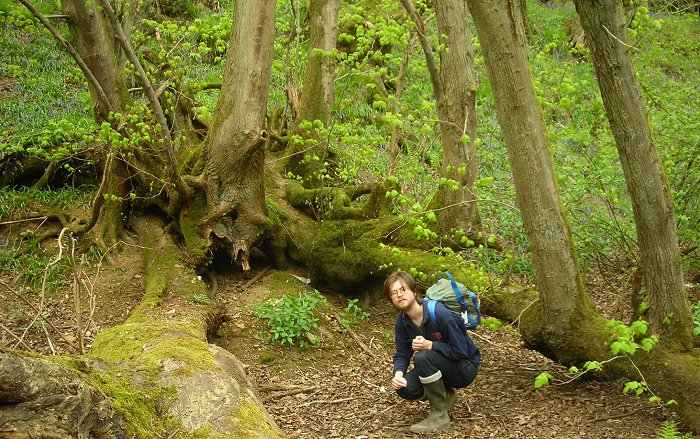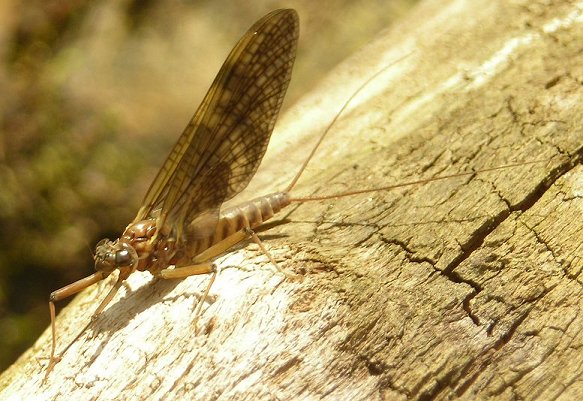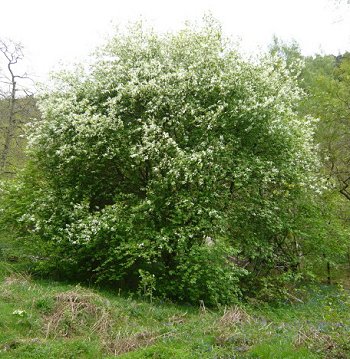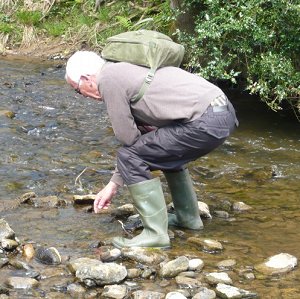
Back to the Index page

For our second trip of the season I am delighted to say we had another good turn-out – and the sun shone; 18 members and guests met at Carlton where Janet explained what we were going to do and see. Then we took the cars down along the forest road into Riccal Woods where we parked. Before we set off to walk along the track and explore the flora and fauna we examined the skull of a roebuck, with horns, that had been found in Beadale Wood. The consensus was that this was probably a young male, since some of the teeth were not fully through, and none of them showed any wear. Several of us were surprised by how small it was, as one tends to think of deer as large animals. Roe deer are, of course, very much smaller than either red or fallow deer.
We then walked along the forest track, the group rapidly splitting with the botanists lagging at the back, down on their hands and knees examining small green things, and everyone else sensibly going ahead at normal walking speed, listening for birds, spotting the numerous wood ants crossing the road, and generally taking in the beautiful surroundings. [This always happens!]
As the track dropped down towards the river we came to the end of the conifer plantation to our right and the whole hillside was carpeted in blue: this must be one of the best bluebell woods I have ever seen, and we had hit on exactly the right day, with the flowers absolutely at their best – a feast not only for the eyes since the honey-scent was also strong. Everyone was impressed, and it certainly lived up to expectations. Closer examination showed that there was a scattering of pure white individuals in the sea of blue, which is not uncommon in Ryedale. The other notable plant here was bird cherry, also at its peak; I don’t think I have ever seen so many large bird cherries growing together – this is a very special place.

Bluebells under the trees – notice the bird cherry to the right
We then dropped down to the river, and paused at the footbridge. Tom pointed out the position of a dipper’s nest on the far bank, but as there was another party pic-nicking on the bridge the birds were sensibly staying away. We walked a little further upstream and stopped for our own lunch. A bit of exploring at the edge of the woods found a truly enormous old coppice lime: all the ‘trees’ you can see in the picture (and then some!) are from the same coppice stool, which must be many hundreds of years old. We thought it might be the native small-leaved lime Tilia cordata, but without the flowers it is almost impossible to tell, and they won’t be out for another few weeks. Close examination of the shoots revealed that the leaf-stalks were hairy, as were the veins on top of the leaf and almost the whole of the underside, with thick white tufts of hair in the vein axils. It is impossible to be sure on such young leaves, but I think this rules out small-leaved. [Later: in fact this tree is small-leaved: Mags checked it out on 15th July and it showed the typical erect inflorescences, and tufts of buff hairs in the leaf axils. So, the message is you cannot identify limes from very young shoots!]

Huge lime coppice – all the trees you can see are from the same stool
There were also some very old oaks in this part of the wood, and one area with large coppiced alders which had each grown back into a circle of about 5 quite large trunks, each almost a tree in its own right.
After lunch some of us went back to the dipper’s nest – the other party had now moved on – and a few were lucky enough to see the parent bird arriving to feed the young, and several others at least spotted a dipper flying down the river. Dippers are one of my favourite birds and it is good to see them doing well. I also saw a fish jump, probably a brown trout.

We then went a little further up-river and those with wellies went for a paddle and re-visited our childhood, happily turning over stones and poking about with a dipping net. We fished out several freshwater shrimps and numerous mayfly larvae of various sizes each with three long ‘tails’ – one was quite a monster at least an inch long – plus some pinkish jelly-like eggs (fish?). I also managed to get a shot of this mayfly (note only two ‘tails’) basking on the dead branch at the water’s edge. (I thought it was a stonefly but I’ve been put right: it’s Palingenia longicauda, one of the largest mayflies in Europe – thanks to Stuart for the id.) Sadly we didn’t manage to find any bullheads: either they aren’t as common as they were when we were children or we’ve lost the knack! Gordon saw otter footprints along the riverside, but no spraints.

Mayfly, about an inch long excluding the tails
After admiring our catches they were all released back into the river and we moved on, picking up the footpath back up to the track and then returning to the cars. On the recce on the Thursday evening Tom & Janet saw what they believe to be lampreys spawning. There were four of them. When first disturbed, (by trying to catch one in the net) they half buried themselves in sand or fine river-bottom debris, lying absolutely straight to appear stick-like. Tom & Janet then left the river and concentrated on finding where the dippers were feeding young. After spotting the dipper nest, they went back to the river and watched the lampreys suckering on to pebbles to move them aside, making a small area of exposed sandy bottom. Then one lamprey suckered itself to a larger pebble, a second seemed to sucker itself to the back of the first lamprey’s head/neck – a lot of writhing went on and the water became cloudy with sand. Presumably there were also eggs in the cloudiness. Tom was getting concerned they might be disturbing the dippers as the lamprey activity was quite close to the nest site, so they left. Sadly for us there was no sign of the lampreys, but I do wonder if those eggs might have been theirs.
Back at the cars we thanked Janet for a most successful day. I think this piece of woodland was a revelation to most of us – you’d never suspect the riches hidden here deep in the forest. And special thanks to Tom for carrying his telescope all the way round so we could get a close view of those dippers!
Thanks to Bob Coursey for the bird list – 22 is a good haul, although I must admit I’m surprised there is no woodpecker recorded. I certainly noticed a lot of chiff-chaffs and blackcaps singing as we walked along.
Insects seemed to be thin on the ground, probably because of the cold winds over the past few days. I only saw three butterflies, probably all green-veined whites. There were plenty of wood ants, and the stonefly and mayfly larvae down at the river, but little else.
As for other animals, Gordon reported otter footprints, and I noticed some footprints that might have been made by deer, and saw one fish jumping in the river. I’m sure there are many more mammals in these woods and meadows, but they are very elusive. Perhaps I just didn’t look hard enough because I was transfixed by the sight of those bluebells....
[122 incl. hybrids] Also at least two willowherbs in leaf, almost certainly broad-leafed (E. montanum and either American (E. ciliatum) or square-stalked (E. tetragonum), and possibly Yarrow (Achillea millefolium). |
 Bird cherry; photo by Mike Gray  Tom after bullheads; photo by Mike Gray |
(including Carlton – but not counting an unidentified gull!)
| Sparrowhawk | Accipiter nisus |
| Pheasant | Phasianus colchicus |
| Swift | Apus apus |
| Barn Swallow | Hirundo rustica |
| House Martin | Delichon urbica |
| Pied Wagtail | Motacilla alba yarrellii |
| Dipper | Cinclus cinclus |
| Wren | Troglodytes troglodytes |
| Robin | Erithacus rubecula |
| Blackbird | Turdus merula |
| Mistle Thrush | Turdus viscivorus |
| Blackcap | Sylvia atricapilla |
| Chiffchaff | Phylloscopus collybita |
| Willow Warbler | Phylloscopus trochilus |
| Blue Tit | Parus caeruleus |
| Great Tit | Parus major |
| Jackdaw | Corvus monedula |
| Carrion Crow | Corvus corone corone |
| Starling | Sturnus vulgaris |
| House Sparrow | Passer domesticus |
| Chaffinch | Fringilla coelebs |
| Goldfinch | Carduelis carduelis |
Back to the top and Index page
© Ryedale Natural History Society 2009; Photos © Gill Smith and Mike Gray 2009